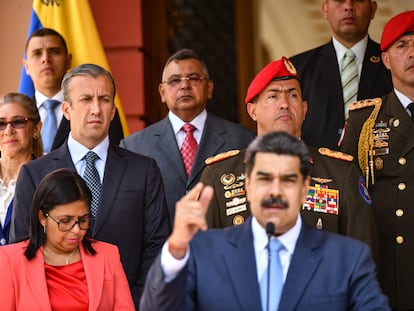Forced disappearances plague the Colombia-Venezuela border
During the last few decades of the 20th century, most of the people who vanished between the two countries were Colombians, looking for better lives in wealthy Venezuela. The migration has reversed course, but people are still dying without a trace


A man sits at home staring through the iron bars of the front gate. He peers out whenever a car pulls up, hoping against hope that it’s his son. He would like to search for his boy, but he’s 92 and in a wheelchair. Aleixis Luna Aguilar sold Christmas lights door to door. Two years ago, he went out to deliver an order and never returned. There are no traces of his body or the motorcycle he was riding. No one knows what happened, just like dozens of others who have disappeared in the hotbed of organized crime along the Colombia-Venezuela border.
Maria Antonia Aguilar, Aleixis’ mother, wears a permanently downcast expression. She lives with Samuel Luna — the man at the window — in a spartan house in Villa del Rosario, a town on the eastern edge of Colombia near the Venezuelan border. It looks like all the other houses except for the sign on the wall denouncing the disappearance of their 43-year-old son Aleixis. The family earns a little money from the small convenience store in their home. Maria Antonia’s hands are wrinkled by age and hard work. She looks down, her teary eyes darting from side to side, and lets out a choked whimper. “My son is an honest, hardworking man — no vices at all,” said the 77-year-old woman.
The family has gone to all the morgues, hospitals and jails looking for Aleixis. They reported his disappearance to the authorities, but doubt that an investigation was ever opened. Aleixis was last seen in Herrán, a small town to the south. With photo in hand, the family went house to house there, asking if anyone had seen him. They bought radio ads and asked a priest for help. “People vanish easily on this border, like a dove in a magician’s hat,” said Donal, Aleixis’ brother.
Colombia has a 1,200-mile (2,000 kilometer) border with Venezuela. Just like the U.S.-Mexico border, it teems with activity and danger. Cúcuta, one of the largest Colombia border towns, has been plagued by violence since the 1950s when millions of poor Colombians emigrated in search of work and better lives in oil-rich Venezuela.
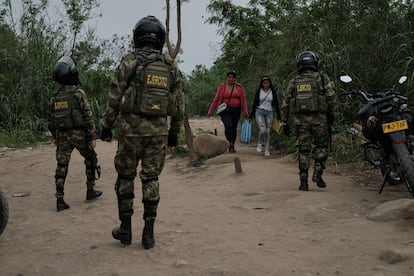
Cúcuta is one of the 50 most violent cities in the world, according to the Citizen Council for Public Security and Criminal Justice, a Mexican NGO. Criminals of every stripe converge there, attracted by the billions of dollars flowing along the border from smuggling and drug trafficking. Over 336 tons of cocaine are produced annually in the Catatumbo region west of Cúcuta, according to Colombian police. So many criminal organizations operate there that no one is sure who has the upper hand. The Gulf Clan, FARC dissidents, ELN guerillas, Tren de Aragua, Los Pelusos… The police have identified 16 drug-trafficking gangs in the city.
Aleixis disappeared when he took one of the many “trochas” (unmarked trails) to cross into Venezuela. Many people have dual nationality in the border region. In the late 1970s, Colombians were disappearing in Venezuela, but now the opposite is happening. The number of annual disappearances in Colombia is chilling — over 100,000. The many local paramilitary groups have become experts in disappearing the bodies of their victims. In Cúcuta, they even built ovens to incinerate corpses.
Nelly's story
Aura Etelvina Velandia can’t even cry for her lost daughter. The 79-year-old woman is blind from Sjogren’s syndrome, an autoimmune disease that prevents her from producing tears. “We don’t know if she’s alive or dead. It’s like the ground swallowed her up,” she said wistfully. Her 39-year-old daughter Nelly Martínez disappeared at the border in October 2018. She went out one afternoon and said she’d be right back after paying a debt with money she earned from selling smuggled gasoline in her Cúcuta neighborhood. Gasoline smuggling has long been a major source of income for Colombians in the border region because it’s so heavily subsidized in Venezuela. Now people smuggle gas into Venezuela.
The last time Nelly contacted her family, she was about to go down an unmarked trail when two armed men forced her onto a motorcycle right next to a police station. Nelly said they were from the La Linea gang.
Nelly lived with her daughter, Julieth Carreño, in a brick house with a red tile roof surrounded by a dusty courtyard in Cúcuta. A poster with information about Nelly’s disappearance hangs on her living room wall. Carreño says she was treated badly by the Colombian justice system. The investigative arm of the Colombian National Police (SIJIN) told her the case had been closed, and a hostile local official refused to let her see the prosecutor, who was supposedly handling the case. “The only thing I care about is knowing if she’s dead so we can have closure and bury her properly — we want to know where she is,” she said.
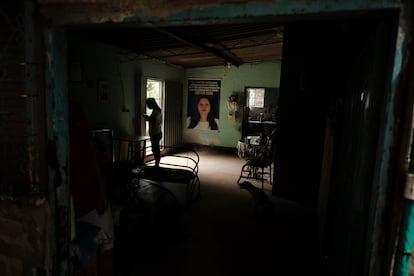
A son’s ghost
Rosa Reyes has crossed into Colombia dozens of times looking for her son. If someone says they saw a homeless man, Rosa runs to look for him. Her 23-year-old son, Jhaylander Raúl Arévalo, rode his motorcycle from La Fría, Táchira (Venezuela), to Cúcuta in April 2022. Cameras on the San Gerardo trail captured him crossing into Colombia, but there is no recording of his return trip.
Reyes and her son were both merchants who traveled frequently to Cúcuta. They used the trails because Venezuelan President Nicolás Maduro closed the borders for seven years until the two nations reestablished diplomatic relations in 2022. The trails were never closed and are controlled by various criminal organizations.
Reyes battled the bureaucratic justice system, getting bounced around from the local prosecutor to the SIJIN and back to the prosecutor. When they finally took her complaint, they handed her a blank piece of paper instead of information about her son. She never receives a response when she asks about the progress. “They tell me I can’t be going there all the time, that it’s not the way it works. He was a clean-living, hardworking boy – my only son,” she said.
Reyes has spent days and nights handing out flyers and tacking them on posts in Cúcuta. Someone once called to tell her they had her son and demanded two million pesos ($450). Reyes borrowed money and paid the ransom, but then the man demanded more and threatened to kill her son. She agreed, but there was no sign of life — it was a scam. Someone else called to say her son was being held at the Mexican border. Reyes realized they were extortion calls, an ugly form of re-victimization.

Traveling the trails
The dirt road leading to the La Platanera trail in Villa del Rosario is steep and winding. ELN (the National Liberation Army guerilla group) graffiti defaces the walls of several houses with messages threatening Tren de Aragua, a cross-border criminal gang locked in a turf war with the ELN.
EL PAÍS requested a military escort to travel the trails leading to the border and 35 armed men were assigned to guard us all the way to the Venezuelan border. The tension is palpable — people standing in doorways scurry away when they see our vehicles. The sky is cloudy, and the heat is suffocating.
On the Venezuelan side of the border, armed men wearing Bolivarian National Guard uniforms stand guard. Several pull balaclavas over their faces and hide behind trees. The Táchira River delineates the border, but the river is dry from the drought, and we can walk along the riverbed. The Venezuelan guards bristle when we arrive and make signs that no photos are allowed. A dog barks furiously. People coming from Venezuela pass by, pushing wheelbarrows and carrying sacks on their shoulders. They walk across a makeshift plank bridge over one of the few streams that still have water. We are told the Venezuelan guards charge a 2,000-peso fee (less than a dollar) or more to cross, depending on their merchandise. Most are working-class people looking for food items that can’t be found in Venezuela. Venezuela’s official currency has devalued so much that only U.S. dollars and Colombian pesos are used. The big smugglers use other trails wide enough for vehicle traffic.
Everyone we ask about the disappearances is reluctant to speak — silence is best. “No flies enter closed mouths,” said a street vendor. “It’s like the law doesn’t exist around here,” said another man, who put a finger to his lips and continued on his way.
Since the border opened up again in 2022, over 50,000 people travel every day in both directions over the international bridges, which are legal crossings. There is a permanent police presence there, unlike the trails that are swept daily by military troops, according to Colombian Army Major Dietrich Acero. Colonel Juan Carlos Ramírez, the local police commander, says they just don’t have the capacity to cover the 42 illegal crossing points in that area.
Illegal border crossings are perfect for criminals who commit crimes in one country and take refuge in the other, confident that no one will look for them there. We learned that the illegal crossing points are ELN territory, and the urban surroundings of the Simón Bolívar International Bridge are controlled by Tren de Aragua. The latter group has grown so large and spread so much terror that many petty criminals who aren’t with Tren de Aragua use its name to intimidate their victims.
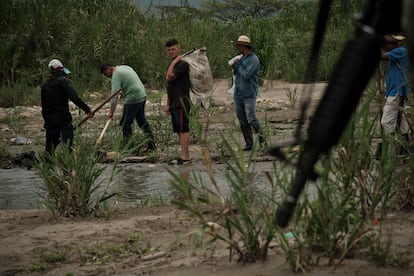
Murky data
The Cúcuta region is the most violent and dangerous part of the long border between the two countries, and has most missing persons cases. When the border was reopened, reports of disappearances dropped, but no official missing persons registry is maintained — it’s a crime that often goes unreported.
Gonzalo Orduz is a local journalist who has been documenting and publicizing disappearances in a Facebook group for years. Rarely a week goes by that he doesn’t post about a fresh case of mothers looking for children, children looking for parents — mostly Venezuelans.
The Progresar Foundation in Cúcuta is a human rights organization that has located 25 potential mass gravesites with bodies of people who disappeared at the border. They informed the authorities about the mass graves but received no response. The foundation monitors 715 missing persons cases resulting from the region’s armed conflict, 150 of them cross-border cases. Only 1% of the cases are ever resolved. “Impunity reigns here. There is no will or action by any Colombian authority to investigate the cases,” said Wilfredo Cañizares, the foundation’s director.
Cañizares insists that these forced disappearances are systematic. He points to official corruption and complicity with binational organized groups, and says Venezuelans murdered in Colombian are dumped on the other side of the border so they don’t show up in Cúcuta’s crime statistics. “This city is experiencing a violent human rights crisis,” he said.
Enrique Pertuz, a human rights activist, maintains a record of 6,017 people who have been disappeared on both sides of the border. Pertuz told us about the “casas de pique”, where victims are dismembered. Tren de Aragua has several of these slaughterhouses in Villa del Rosario. “The crime of forced disappearance has always existed, whether or not the border is open. It’s triggered by irregular migration,” said Pertuz. The prosecutor for the North Santander department only has 742 open disappearance cases, according to Director Jesús Antonio Ardila.
A Venezuelan legislator named Juan Carlos Palencia intends to ask the Colombian Congress to create a binational commission to investigate disappearances. His inquiry discovered that some of the disappeared were recruited by illegal armed groups, while others were victims of human trafficking and kidnapping. Disappearances peaked shortly after the border was closed in 2015. Venezuelan foundation FundaRedes reported 334 disappearances and/or kidnappings in 2022, all Venezuelans.
Edwin López owns the San Martín funeral home and has collected dozens of corpses along the border. It’s humanitarian work, he says, and doesn’t get paid for it unless a family requests funeral services. He’s the man authorities turn to when they need a body picked up outside their jurisdiction where only a hearse can venture. Some bodies display signs of torture and are so decomposed that they remain unidentified in the morgue. “There is no fingerprint database of Venezuelans we can use to help identify a corpse here,” he said. Recently, López has stopped traveling the trails looking for bodies — it’s just too dangerous. But that doesn’t mean business is slow — he picked up 11 bodies just the other night.
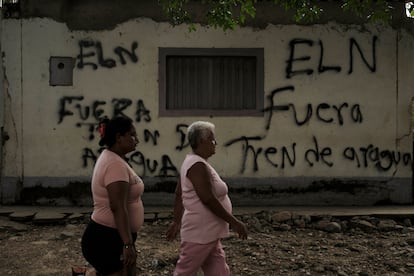
In a country accustomed to rationalizing crime and barbaric violence, families insist their disappeared relatives were innocents who didn’t deserve that fate. Criminals try to erase all traces of their victims, but there is no way to erase the horror. One question always lingers: where are they?
Sign up for our weekly newsletter to get more English-language news coverage from EL PAÍS USA Edition
Tu suscripción se está usando en otro dispositivo
¿Quieres añadir otro usuario a tu suscripción?
Si continúas leyendo en este dispositivo, no se podrá leer en el otro.
FlechaTu suscripción se está usando en otro dispositivo y solo puedes acceder a EL PAÍS desde un dispositivo a la vez.
Si quieres compartir tu cuenta, cambia tu suscripción a la modalidad Premium, así podrás añadir otro usuario. Cada uno accederá con su propia cuenta de email, lo que os permitirá personalizar vuestra experiencia en EL PAÍS.
¿Tienes una suscripción de empresa? Accede aquí para contratar más cuentas.
En el caso de no saber quién está usando tu cuenta, te recomendamos cambiar tu contraseña aquí.
Si decides continuar compartiendo tu cuenta, este mensaje se mostrará en tu dispositivo y en el de la otra persona que está usando tu cuenta de forma indefinida, afectando a tu experiencia de lectura. Puedes consultar aquí los términos y condiciones de la suscripción digital.
More information
Archived In
Últimas noticias
Most viewed
- Sinaloa Cartel war is taking its toll on Los Chapitos
- Oona Chaplin: ‘I told James Cameron that I was living in a treehouse and starting a permaculture project with a friend’
- Reinhard Genzel, Nobel laureate in physics: ‘One-minute videos will never give you the truth’
- Why the price of coffee has skyrocketed: from Brazilian plantations to specialty coffee houses
- Silver prices are going crazy: This is what’s fueling the rally
